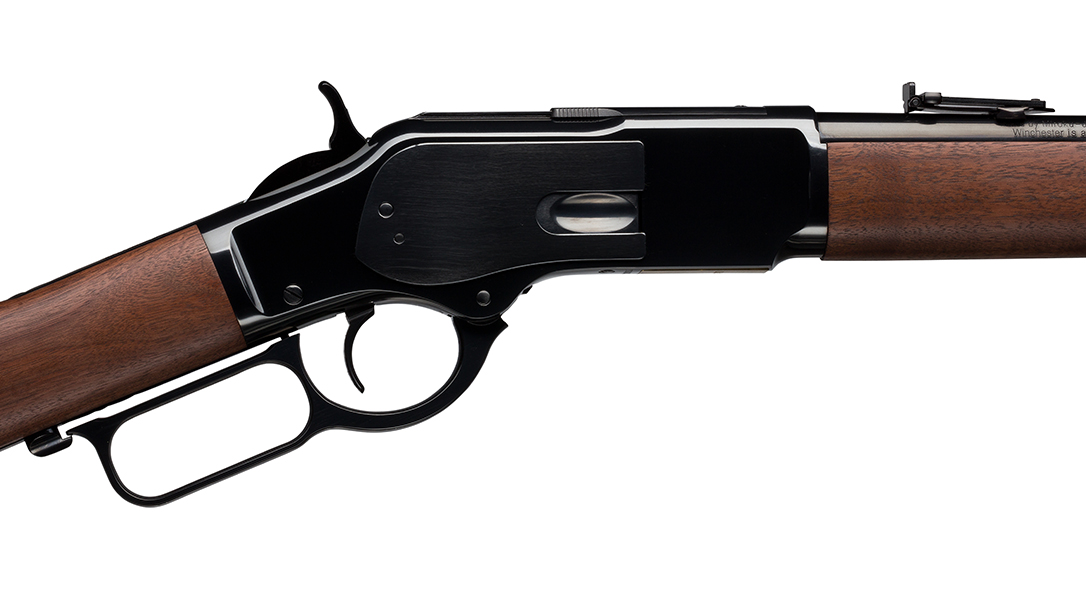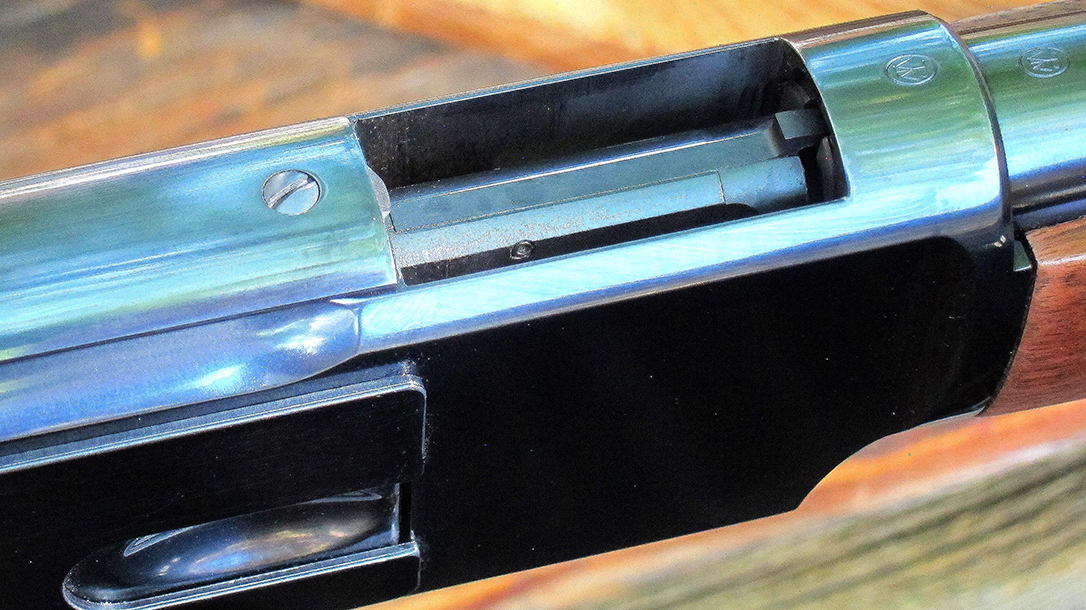Remember the 2003 film Open Range? Robert Duvall starred alongside Kevin Costner, who also served as the director and the main ramrod behind the film adaptation of Lauran Paine’s 1990 novel The Open Range Men. Along with having an amazing cast, the film had several noteworthy scenes, including a final shootout ranking high in the history of Westerns.
Guns were obviously central characters in all of the drama. You’ll see a Remington Model 1875 and Colt Model 1873 Singe Action Army revolvers, not to mention a few coach guns and various Winchester Model 1873 carbines and rifles, reflecting a fairly authentic mix of what you would’ve seen at such a fracas in that era.
Advertisement — Continue Reading Below
Of course the Winchester Model 1873s—Uberti replicas—stand out the most for me. I’ve bugged the good folks at Browning, which owns Winchester, to release a standard-production saddle ring carbine as part of its Miroku-built line ever since they reintroduced the Model 1873 in 2013. And while I seriously doubt I had anything to do with it, the company finally did just that in 2018. I immediately put in a request for a test sample, and when it arrived, I liked it so much that I mailed a check for it before I even had a chance to fire it. It is a beauty.
Winchester 1873 – Worth The Wait
The original Model 1873 was one of Winchester’s most popular rifle designs, manufactured from 1873 well into more modern smokeless-powder times, and it was dropped from production after a 50-year run in 1923, with over 720,000 produced. When the company decided to resurrect the line using the Miroku factory in Kochi, Japan, several different configurations were eventually produced, but none were true carbines. Until now, that is.
At long last, those of us who wanted a trim, high-quality 1873 built with modern materials and techniques—and the right buttplate for softer shooting—finally have it. No, it’s not made in the U.S., but the new Winchester Model 1873 Carbine is a step above other imports on the block, and this reproduction is actually branded “Winchester.” Another huge selling point is the total absence of the lawyer-induced safety “upgrades” that were incorporated into the Miroku-made 1892s, 1886s and 1894s. You won’t find a rebounding hammer or tang safety on these 1873s.
Advertisement — Continue Reading Below
On the outside, the new 1873 looks identical to an ancestor from 100 years ago, with the exception of a barely noticeable screw arrangement behind the sliding dust cover on top of the receiver that marks the trigger-linked internal firing pin block. This block is the only “safety” modification, and if you grew up with a half-cock hammer on your lever guns like me, you’ll feel right at home here.

Timeless Design
On the inside, the new Winchester operates with the same toggle-link action your great-great-grandpa was using when Jesse James was pursuing an executive career in railroads and banking, but with much better heat-treating and much stronger steels. The trigger is mechanically blocked until the lever is fully closed, the action cover opens automatically when the action is cycled, and a swiveling stud in the lower tang locks the lever closed. The 1873’s lockup is nothing like the later Browning-designed lever guns, and the lever can move around if the gun’s jostled.
Otherwise, it’s a carbine all the way, from the comfortably curved, polished steel buttplate, barrel bands and 20-inch barrel to the correctly executed saddle ring (with a staple, not a stud) and ladder-style rear sight. The bluing is deep and dark, the inletting is clean, and the wood-to-metal fit in key areas like the tang and forend is near perfect. The oil-finished walnut has no varnish to scratch, the hammer spur is finely checkered, and the trigger is tuned to break cleanly at just under 5 pounds with no overtravel.
Advertisement — Continue Reading Below
How It Shoots
Miroku puts out some of the best Winchesters ever built. But looks aren’t everything, and I didn’t buy this carbine to hang it over the mantle. I chose the .45 Colt version, even though that caliber wasn’t available in original 1873s. I just happened to have half a dozen or so handguns to match it, along with a wagonload of brass, so that was a no-brainer.
Range day was bright and sunny with 10- to 12-mph winds. To test the Winchester’s accuracy and see how well the sights were regulated, I fired five different factory loads at a paper target 100 yards away using a benchrest. The ladder sight has “0-20” markings that don’t match up with any particular yardage, so I needed to experiment with each load to see if elevation adjustments were necessary.
Accuracy Revealed
That said, the carbine was dead on with Black Hills’ 250-grain round-nose flat-point (RNFP) ammo. With the ladder folded down, my shots dropped roughly 6 inches below the point of aim. I obtained similar results with Remington’s 250-grain RNFPs, and the elevation stayed between 5 to 8 inches low with Sig Sauer’s 230-grain V-Crown jacketed hollow points (JHPs), Federal’s 225-grain semi-wadcutter hollow points (SWCHPs) and Winchester’s 225-grain Silvertip JHPs.
Advertisement — Continue Reading Below
When using the “0” setting on the ladder notch, my impacts were very close to the point of aim. I was able to put three shots into an inch at 100 yards, which turned out to be the best result of my range session. Thus, the gun was regulated for 50-yard shooting with the ladder down and 100-yard shooting with the ladder on its lowest setting. More experimentation was required, but I knew that the Winchester could shoot lead and jacketed ammo quite well. In fact, the carbine fired everything I put through it. It’s also worth noting that the hammer spring is noticeably heavier when it comes to opening the action than other imports I’ve tried, and the rear sight notches are pretty tiny, which is good for accuracy but not speed.
Light is Right
The gun seemed to prefer lighter bullets but didn’t show a major preference; this gives me a wide range of options in working up loads for it. If you decide to go with quicker sights, a more open rear buckhorn would be a simple swap. However, with the front base soldered to the barrel, it’d require technical skills to remove it and cut a dovetail. As is, the front brass blade makes a good contrast in the black rear notches in sunlight when it’s new, but it’ll develop a patina as it ages. If you want to keep a bright contrast up front, it wouldn’t take much to have a gunsmith fabricate and install a German silver blade to replace it.
Incidentally, the loading gate is very thumb friendly. Long range sessions with new lever guns almost always send me home with a torn-up thumb, scraped by sharp loading port edges, and almost worn out from forcing rounds in against heavy spring tension. That wasn’t the case here. The port edges aren’t sharp, and the spring tension is so light I was able to load rounds with my left hand while holding the gun with my right. This is almost unheard of. I’ve had to soften a lot of the loading port edges on other lever guns.
Advertisement — Continue Reading Below
The Smoke Clears
Sure, I’d like to see Winchester lever-gun manufacturing return to the land of its birth. But it’s not going to happen. And Miroku’s quality exceeds anything the brand put out for quite some time before domestic production ended with the Model 94 in 2006. In the meantime, you won’t find a better-made Winchester lever gun made anywhere. Buying one of these 1873s today is very much like walking into a hardware store in 1895 to buy a new rifle then. You get a brand-new Winchester of known quality in a proven and deservedly popular design. You also get the added bonus of 145 years of history and adventure behind every shot you fire through it.
Since carrying a box of shells in your pocket isn’t “cowboy cool,” you’ll need leather. For something to match the quality and authenticity of the Winchester, I asked Matt Whitaker at John Bianchi Frontier Gunleather to craft one of the company’s Bandito bandoleers. My chestnut version with border stamping and a silver concho carries 30 rounds of .45 Colt ammo in tight loops that won’t let any out until you want them out, and it’s suede lined and adjustable.
Advertisement — Continue Reading Below
Don’t just sit back and read about it. Create your own history and live your own adventures with this carbine and leather combo. And don’t forget to catch Open Range the next time it runs on TV.
For more information, visit winchesterguns.com and frontiergunleather.com.
Winchester Model 1873 Carbine
- Caliber: .45 Colt
- Barrel: 20 inches
- Overall Length: 39 inches
- Overall Weight: 7.25 pounds (empty)
- Stock: Walnut
- Sights: Blade front, adjustable rear
- Action: Lever
- Finish: Blued
- Overall Capacity: 10+1
- MSRP: $1,300
Winchester Model 1873 Carbine Performance
Load: Accuracy
Advertisement — Continue Reading Below
- Black Hills 250 RNFP: 3.75
- Federal 225 SWCHP: 1.00
- Remington 250 RNFP: 3.25
- Sig Sauer 230 V-Crown JHP: 2.00
- Winchester 225 Silvertip: 2.31
Bullet weight measured in grains and accuracy in inches for best three-shot groups at 100 yards.
This article is from the Fall 2019 issue of Guns of the Old West magazine. Grab your copy at OutdoorGroupStore.com. For digital editions, visit Amazon.






























